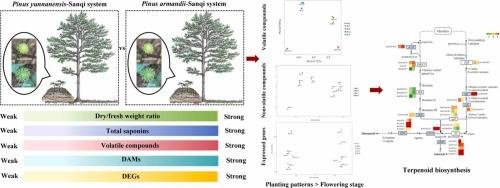Unveiling the molecular regulations of terpenoid biosynthesis in Sanqi flowers across two cultivation systems and flowering stages using multiomics approaches
IF 6.2
1区 农林科学
Q1 AGRICULTURAL ENGINEERING
引用次数: 0
Abstract
The quality of Sanqi flowers is significantly influenced by the cultivation system of Sanqi. However, a comparison of the quality of Sanqi flowers during different flowering stages obtained from the Pinus armandii-Sanqi (PAS) and Pinus yunnanensis-Sanqi (PYS) agroforestry systems has hitherto not been conducted. Herein, a systematic analysis of the molecular mechanisms of terpenoid biosynthesis in the Sanqi flowers was performed using multiomics (GC-MS, LC-MS and transcriptomics) analyses. Totally, 41 and 42 types of volatile organic compounds (VOCs), predominantly classified as sesquiterpenoids, were present in Sanqi flowers from the PAS and PYS systems, respectively. Germacrene D was notably prominent in Sanqi flowers from the PAS system. Moreover, 154 metabolites of nonvolatile terpenoids were identified, which primarily included triterpenoid saponins (84.415 %) and triterpenoids (15.585 %). Cultivation system chiefly contributed to differences in the VOCs and non-VOCs of Sanqi flowers. A total of 45 and 49 differentially expressed metabolites were significantly upregulated in the early and full bloom stages, respectively, of Sanqi flowers from the PAS system. Furthermore, gypenoside XVII, gypenoside IX, notoginsenoside Fd, ginsenoside Rd, and chikusetsusaponin-FK1 were the major non-VOCs. Additionally, the SQLE and GERD genes directly regulated the biosynthesis of triterpenoids and sesquiterpenoids, respectively. The yeast one-hybrid system indicated that MYB61 transcription factor interacted with the GERD gene. Thus, Sanqi flowers of higher quality were obtained from the PAS system. Our results contribute to revealing the molecular mechanisms in terpenoid compounds in Sanqi flowers from the PAS systems, laying the foundation for the application of metabolites in the Sanqi flowers.

利用多组学方法揭示三七花不同栽培体系和花期萜类生物合成的分子调控
三七花卉的品质受三七栽培制度的影响较大。但是,目前还没有对云南松-三七(PYS)和马尾松-三七(PAS)农林业系统不同花期的三七花质量进行比较。本文采用多组学(GC-MS、LC-MS和转录组学)技术对三七花萜类生物合成的分子机制进行了系统分析。在PAS和PYS体系中,三七花中分别检测到41种和42种挥发性有机化合物,主要为倍半萜类化合物。在PAS体系的三七花中,Germacrene D的含量最为显著。此外,鉴定出154种非挥发性萜类化合物的代谢物,主要包括三萜皂苷(84.415 %)和三萜(15.585 %)。栽培制度是造成三七花挥发性有机化合物和非挥发性有机化合物差异的主要原因。在PAS体系中,三七花在开花前期和盛花期分别有45种和49种差异表达代谢物显著上调。绞股蓝皂苷XVII、绞股蓝皂苷IX、三七皂苷Fd、人参皂苷Rd和七皂苷fk1是主要的非挥发性有机化合物。此外,SQLE和GERD基因分别直接调控三萜和倍半萜的生物合成。酵母单杂交系统表明,MYB61转录因子与GERD基因相互作用。因此,从PAS体系中获得了品质较高的三七花。本研究结果有助于从PAS系统中揭示三七花中萜类化合物的分子机制,为三七花代谢产物的应用奠定基础。
本文章由计算机程序翻译,如有差异,请以英文原文为准。
求助全文
约1分钟内获得全文
求助全文
来源期刊

Industrial Crops and Products
农林科学-农业工程
CiteScore
9.50
自引率
8.50%
发文量
1518
审稿时长
43 days
期刊介绍:
Industrial Crops and Products is an International Journal publishing academic and industrial research on industrial (defined as non-food/non-feed) crops and products. Papers concern both crop-oriented and bio-based materials from crops-oriented research, and should be of interest to an international audience, hypothesis driven, and where comparisons are made statistics performed.
 求助内容:
求助内容: 应助结果提醒方式:
应助结果提醒方式:


